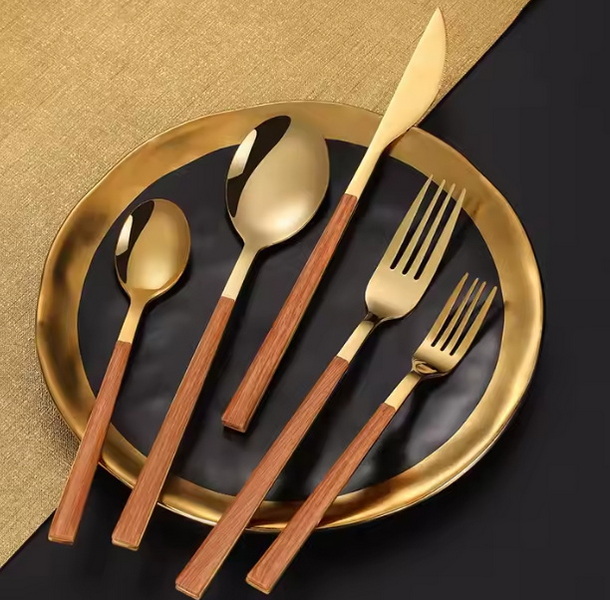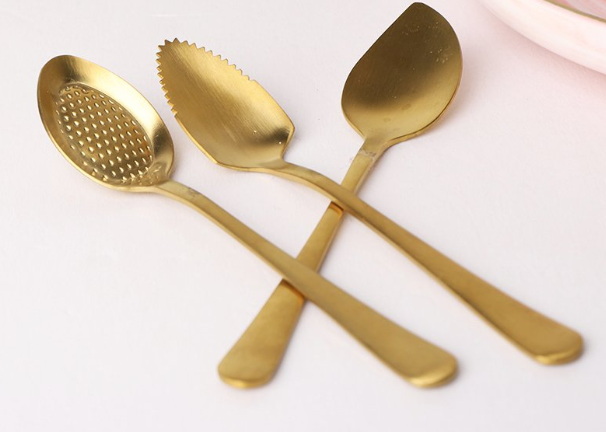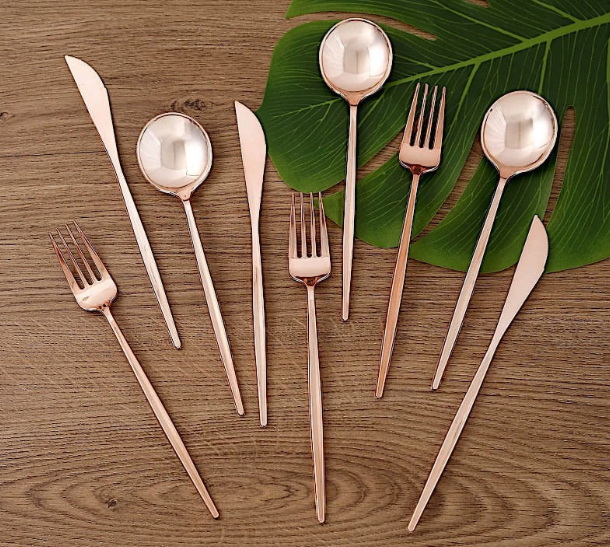
Content Menu
● Introduction to Rose Gold Cutlery
>> Features of Rose Gold Disposable Cutlery
● Safety for Food
>> BPA-Free Plastic
>> Understanding BPA-Free Plastics
● Environmental Impact
>> Biodegradable Alternatives
>> Benefits of Biodegradable Cutlery
● Sustainable Practices
● Innovations in Sustainable Cutlery
● Consumer Awareness and Choice
● Conclusion
● FAQs
>> 1. Is Rose Gold Disposable Cutlery Safe for Food?
>> 2. What Materials Are Used in Rose Gold Cutlery?
>> 3. Can Rose Gold Disposable Cutlery Be Reused?
>> 4. How Does Rose Gold Cutlery Impact the Environment?
>> 5. What Are the Alternatives to Rose Gold Plastic Cutlery?
In recent years, rose gold cutlery disposable has become increasingly popular for its elegant appearance and convenience in various events, from weddings to corporate gatherings. However, concerns about its safety for food and environmental impact have also grown. This article delves into the details of rose gold disposable cutlery, exploring its safety, environmental considerations, and whether it is a sustainable choice for modern events.

Introduction to Rose Gold Cutlery
Rose gold cutlery, often made from high-quality plastic, is designed to mimic the luxurious look of real metalware without the hassle of washing and storing. It is commonly used in parties, weddings, and other special occasions where a touch of elegance is desired. The appeal of rose gold cutlery lies in its ability to add sophistication to any table setting, making it ideal for upscale events.
Features of Rose Gold Disposable Cutlery
1. Elegant Appearance: Rose gold cutlery adds a sophisticated touch to any table setting, making it ideal for upscale events.
2. Convenience: Disposable, eliminating the need for washing and storage.
3. Durability: Made from heavy-duty plastic, it is sturdy enough to handle various types of food.
Safety for Food
When it comes to food safety, the primary concern is whether the materials used in rose gold cutlery are safe for consumption. Most rose gold plastic cutlery is made from BPA-free plastic, which is non-toxic and safe for use with food.
BPA-Free Plastic
BPA (Bisphenol A) is a chemical found in some plastics that can leach into food and water, potentially causing health issues. BPA-free plastics are designed to eliminate this risk, ensuring that the cutlery does not contaminate food. This is particularly important for events where food is served, as it ensures that guests can enjoy their meals without worrying about the safety of the utensils.
Understanding BPA-Free Plastics
To understand the significance of BPA-free plastics, it's essential to consider the potential health risks associated with BPA. Studies have shown that exposure to BPA can lead to various health problems, including reproductive issues and increased risk of certain cancers. Therefore, opting for BPA-free rose gold cutlery is crucial for maintaining food safety.
Environmental Impact
The environmental impact of disposable cutlery is a significant concern. Traditional plastic cutlery, including rose gold varieties, is often made from non-biodegradable materials like polypropylene and polystyrene, which contribute to plastic waste and pollution. These materials do not decompose naturally and can persist in the environment for hundreds of years, contributing to the growing problem of plastic pollution.
Biodegradable Alternatives
For those seeking a more eco-friendly option, biodegradable cutlery made from materials like PLA (polylactic acid) is becoming increasingly popular. PLA is derived from plant materials such as corn starch or sugarcane and is compostable, reducing the environmental footprint of disposable cutlery. This shift towards biodegradable materials can significantly mitigate the environmental impact of rose gold cutlery.
Benefits of Biodegradable Cutlery
Biodegradable cutlery offers several benefits over traditional plastic options:
- Compostable: PLA cutlery can be composted, reducing waste sent to landfills.
- Renewable Resources: Made from plant-based materials, reducing reliance on fossil fuels.
- Non-Toxic: Safe for the environment and does not release harmful chemicals during decomposition.

Sustainable Practices
To mitigate the environmental impact of rose gold disposable cutlery, several sustainable practices can be adopted:
1. Reuse: Some rose gold cutlery sets are designed to be reusable, reducing waste by allowing them to be washed and used multiple times. This option is ideal for frequent users who want to maintain the aesthetic appeal of rose gold without contributing to disposable waste.
2. Recycling: Opt for cutlery made from recyclable materials and ensure it is properly recycled after use. While not all rose gold cutlery is recyclable, choosing options that are can help reduce waste.
3. Compostable Options: Consider switching to biodegradable cutlery for events where possible. This not only reduces plastic waste but also supports sustainable practices.
Innovations in Sustainable Cutlery
The market for sustainable cutlery is evolving rapidly, with new innovations emerging to address environmental concerns. Some companies are developing cutlery from edible materials or natural fibers, offering a zero-waste solution for events. These innovations highlight the potential for rose gold cutlery to transition towards more sustainable materials while maintaining its aesthetic appeal.
Consumer Awareness and Choice
Consumer awareness plays a crucial role in driving demand for sustainable products. By choosing eco-friendly alternatives to traditional rose gold cutlery, consumers can influence manufacturers to produce more environmentally responsible products. This shift in consumer behavior can lead to a broader adoption of sustainable practices across the industry.
Conclusion
Rose gold disposable cutlery offers a stylish and convenient solution for events, but its environmental impact and food safety must be considered. While BPA-free rose gold cutlery is safe for food, the environmental implications of traditional plastic materials necessitate a shift towards more sustainable options like biodegradable cutlery. By adopting sustainable practices and choosing eco-friendly alternatives, consumers can enjoy the elegance of rose gold cutlery while minimizing its environmental footprint.

FAQs
1. Is Rose Gold Disposable Cutlery Safe for Food?
Rose gold disposable cutlery is generally safe for food if made from BPA-free plastic, which is non-toxic and does not leach harmful chemicals into food.
2. What Materials Are Used in Rose Gold Cutlery?
Rose gold cutlery is typically made from high-quality plastic, often including materials like polypropylene or polystyrene. However, eco-friendly options made from biodegradable materials like PLA are also available.
3. Can Rose Gold Disposable Cutlery Be Reused?
Some rose gold cutlery sets are designed to be reusable, allowing them to be washed and used multiple times. However, not all disposable cutlery is suitable for reuse.
4. How Does Rose Gold Cutlery Impact the Environment?
Traditional rose gold cutlery contributes to plastic waste and pollution due to its non-biodegradable materials. However, opting for biodegradable or recyclable alternatives can significantly reduce its environmental impact.
5. What Are the Alternatives to Rose Gold Plastic Cutlery?
Alternatives include biodegradable cutlery made from PLA, wooden cutlery, and reusable stainless steel options, all of which offer more sustainable choices for reducing environmental impact.

















